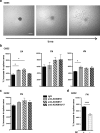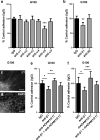Metalloproteinases ADAM10 and ADAM17 Mediate Migration and Differentiation in Glioblastoma Sphere-Forming Cells
- PMID: 27541285
- PMCID: PMC5443867
- DOI: 10.1007/s12035-016-0053-6
Metalloproteinases ADAM10 and ADAM17 Mediate Migration and Differentiation in Glioblastoma Sphere-Forming Cells
Abstract
Glioblastoma is the most common form of primary malignant brain tumour. These tumours are highly proliferative and infiltrative resulting in a median patient survival of only 14 months from diagnosis. The current treatment regimens are ineffective against the small population of cancer stem cells residing in the tumourigenic niche; however, a new therapeutic approach could involve the removal of these cells from the microenvironment that maintains the cancer stem cell phenotype. We have isolated multipotent sphere-forming cells from human high grade glioma (glioma sphere-forming cells (GSCs)) to investigate the adhesive and migratory properties of these cells in vitro. We have focused on the role of two closely related metalloproteinases ADAM10 and ADAM17 due to their high expression in glioblastoma and GSCs and their ability to activate cytokines and growth factors. Here, we report that ADAM10 and ADAM17 inhibition selectively increases GSC, but not neural stem cell, migration and that the migrated GSCs exhibit a differentiated phenotype. We also observed a correlation between nestin, a stem/progenitor marker, and fibronectin, an extracellular matrix protein, expression in high grade glioma tissues. GSCs adherence on fibronectin is mediated by α5β1 integrin, where fibronectin further promotes GSC migration and is an effective candidate for in vivo cancer stem cell migration out of the tumourigenic niche. Our results suggest that therapies against ADAM10 and ADAM17 may promote cancer stem cell migration away from the tumourigenic niche resulting in a differentiated phenotype that is more susceptible to treatment.
Keywords: Cancer stem cell; Cell differentiation; Cell migration; Disintegrin; Extracellular matrix; Glioma.
Conflict of interest statement
Funding
Medical Research Council capacity building studentship to E.J.S.; Wessex Medical Trust (N06), The Royal Society (RG090173) and the Wessex Brain Tumour Fund to S.W.-M.
Conflict of Interest
The authors declare that they have no competing interests.
Figures






Similar articles
-
ADAM17 promotes U87 glioblastoma stem cell migration and invasion.Brain Res. 2013 Nov 13;1538:151-8. doi: 10.1016/j.brainres.2013.02.025. Epub 2013 Mar 5. Brain Res. 2013. PMID: 23470260
-
ADAM17 regulates self-renewal and differentiation of U87 glioblastoma stem cells.Neurosci Lett. 2013 Mar 14;537:44-9. doi: 10.1016/j.neulet.2013.01.021. Epub 2013 Jan 26. Neurosci Lett. 2013. PMID: 23356982
-
CD9 Controls Integrin α5β1-Mediated Cell Adhesion by Modulating Its Association With the Metalloproteinase ADAM17.Front Immunol. 2018 Nov 5;9:2474. doi: 10.3389/fimmu.2018.02474. eCollection 2018. Front Immunol. 2018. PMID: 30455686 Free PMC article.
-
Stem cell signature in glioblastoma: therapeutic development for a moving target.J Neurosurg. 2015 Feb;122(2):324-30. doi: 10.3171/2014.9.JNS132253. Epub 2014 Nov 14. J Neurosurg. 2015. PMID: 25397368 Review.
-
The multifaceted mechanisms of malignant glioblastoma progression and clinical implications.Cancer Metastasis Rev. 2022 Dec;41(4):871-898. doi: 10.1007/s10555-022-10051-5. Epub 2022 Aug 3. Cancer Metastasis Rev. 2022. PMID: 35920986 Free PMC article. Review.
Cited by
-
mTOR Inhibition Is Effective against Growth, Survival and Migration, but Not against Microglia Activation in Preclinical Glioma Models.Int J Mol Sci. 2023 Jun 7;24(12):9834. doi: 10.3390/ijms24129834. Int J Mol Sci. 2023. PMID: 37372982 Free PMC article.
-
The new genetic landscape of Alzheimer's disease: from amyloid cascade to genetically driven synaptic failure hypothesis?Acta Neuropathol. 2019 Aug;138(2):221-236. doi: 10.1007/s00401-019-02004-0. Epub 2019 Apr 13. Acta Neuropathol. 2019. PMID: 30982098 Free PMC article. Review.
-
The metalloprotease ADAM10 (a disintegrin and metalloprotease 10) undergoes rapid, postlysis autocatalytic degradation.FASEB J. 2018 Jul;32(7):3560-3573. doi: 10.1096/fj.201700823RR. Epub 2018 Feb 7. FASEB J. 2018. PMID: 29430990 Free PMC article.
-
Humanin activates integrin αV-TGFβ axis and leads to glioblastoma progression.Cell Death Dis. 2024 Jun 28;15(6):464. doi: 10.1038/s41419-024-06790-8. Cell Death Dis. 2024. PMID: 38942749 Free PMC article.
-
ADAMDEC1 Maintains a Growth Factor Signaling Loop in Cancer Stem Cells.Cancer Discov. 2019 Nov;9(11):1574-1589. doi: 10.1158/2159-8290.CD-18-1308. Epub 2019 Aug 21. Cancer Discov. 2019. PMID: 31434712 Free PMC article.
References
-
- Singh SK, et al. Identification of a cancer stem cell in human brain tumors. Cancer Res. 2003;63:5821–5828. - PubMed
-
- Burger JA, Burger M, Kipps TJ. Chronic lymphocytic leukemia B cells express functional CXCR4 chemokine receptors that mediate spontaneous migration beneath bone marrow stromal cells. Blood. 1999;94(11):3658–3667. - PubMed
Publication types
MeSH terms
Substances
Grants and funding
LinkOut - more resources
Full Text Sources
Other Literature Sources
Research Materials
Miscellaneous

